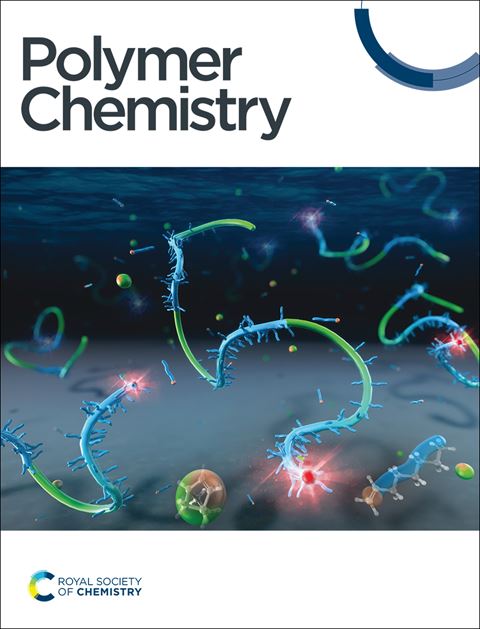生物衍生的长烷基链甲基丙烯酸酯和甲基丙烯酸甲酯的Homo(co)聚合使用易接近的氨基膦基路易斯对
IF 3.9
2区 化学
Q2 POLYMER SCIENCE
引用次数: 0
摘要
路易斯对聚合(LPP)作为一种新兴的有效聚合方法,已被广泛研究和应用于各种聚合物的合成,如聚(甲基)丙烯酸酯、聚酯、聚醚等。引入P-N键在短烷基酰化酯和短烷基甲基丙烯酸酯的可控/活(co)聚合中显示出很大的前景。然而,利用LPP对长烷基链的丙烯酸酯或甲基丙烯酸酯的实验研究却少之又少。长烷基侧链的引入将为探索其对基本材料参数的影响以及调整共聚物的物理性能以适应社会需求提供机会。在这篇论文中,我们通过改变P-N键的数目合成了新的氨基膦LB - bis(N, N-二乙基氨基)甲基膦[(Et2N)2PMe],并将其与iBu3Al结合形成Lewis对(LP),用于MMA和生物衍生甲基丙烯酸月桂酯(LMA)的(共)聚合。(Et2N)2PMe / iBu3Al在单体/ (Et2N)2PMe的摩尔比分别为1600/1和700/1时,均可实现MMA和LMA的可控聚合。利用PLMA的线性链端,采用顺序加成法合成了PLMA-b- pmma嵌段共聚物,并对其物理性能进行了研究。本文章由计算机程序翻译,如有差异,请以英文原文为准。
Homo(co)polymerization of bio-derived long alkyl chain methacrylate and methyl methacrylate using a readily accessible aminophosphine-based Lewis pair
Lewis pair polymerization (LPP), emerging as an effective polymerization method, has been broadly investigated and applied in the synthesis of diverse polymers, e.g. poly(meth)acrylates, polyester, polyethers et al. Introduction of P-N bonds showed great promise in mediating controlled/living (co)polymerization of short alkyl acylates and short alkyl methylacrylates. However, there have been far fewer experimental studies on long alkyl chain of acylates or methyl acrylates using LPP. Introduction of long alkyl side chain would offer the opportunity to explore its influence on basic materials parameters and tune the physical properties of copolymers to cater the society demands. In this contribution, we synthesized the new aminophosphine LB bis(N, N-diethylamino)methylphosphine [(Et2N)2PMe] via variating the numbers of P-N bonds, and combined it with iBu3Al to form the Lewis pair (LP) for the (co)polymerization of MMA and bio-derived lauryl methacrylate (LMA). (Et2N)2PMe / iBu3Al showed both controlled polymerization of MMA and LMA in a monomer/ (Et2N)2PMe molar ratio of 1600/1 or 700/1, respectively. Taking advantage of the linear chain end of PLMA, block copolymer of PLMA-b-PMMA was synthesized via sequential addition method and its physical property was investigated.
求助全文
通过发布文献求助,成功后即可免费获取论文全文。
去求助
来源期刊

Polymer Chemistry
POLYMER SCIENCE-
CiteScore
8.60
自引率
8.70%
发文量
535
审稿时长
1.7 months
期刊介绍:
Polymer Chemistry welcomes submissions in all areas of polymer science that have a strong focus on macromolecular chemistry. Manuscripts may cover a broad range of fields, yet no direct application focus is required.
 求助内容:
求助内容: 应助结果提醒方式:
应助结果提醒方式:


